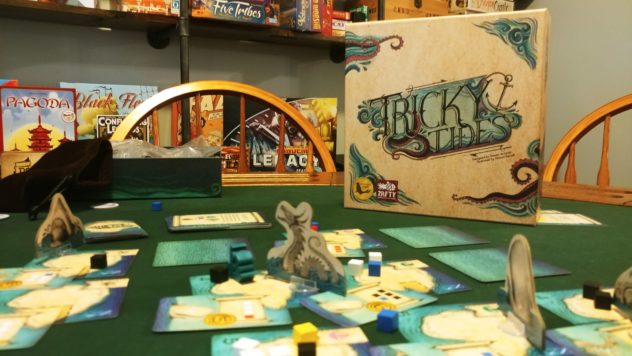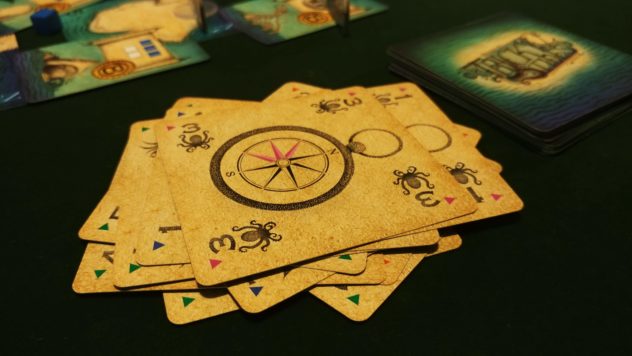I love movies and stories about adventures out on the open sea. Big, giant ships with all kinds of colorful characters. Exploring islands that have never been discovered before. Fighting giant monsters that try to destroy our boat, or maybe just move items around.
Okay, there’s a chance I watch some really weird movies.

Set Sail!
Tricky Tides allows players to sail off an adventure of their own to accomplish every young boy and girl’s dream – trading goods! This beautifully illustrated title from Gold Seal Games (and designed by friend of OBF Steven Aramini) adds a little more flavor, though. You’ll have to work to ensure that you can move where you want to go. You’ll need to keep an eye out for the exchanges that will bring you the most points. And you’ll need to move the monsters around so that they can give you all the benefits.
What monsters? Oh, I’ll tell you about that in a minute.
The game takes place over three rounds. Each round begins with navigation cards being dealt out to all players. These cards feature four “suits” and are numbered one to eight. They also show a compass in the center with some of the arrows highlighted. More on that compass later.

At the beginning of a turn, whoever is the lead player puts a card face up on the table. The card they place sets the suit for that turn. Just like in many trick-taking games, players must match that suit if they can. Otherwise, they can play any other card. The player with the highest card of the lead suit moves their ship first, while the person who played the lowest card of the lead suit gets to move the monster.
What monster? Oh, I’ll tell you about that in a minute.
Land Ho!
The islands that you’ll be navigating are made up of a set of cards placed in the middle of the table. The number of islands you can visit varies depending on the number of players, but instead of shrinking the board, some islands just get flipped over.

The direction that you can sail depends on the card that you played. Remember those highlighted compass arrows? Those tell you which direction you can move your ship. The higher the number on the card, the more arrows are highlighted, and the more options you have for movement.
Each island is populated with a variety of randomly drawn resources at the beginning of each round. The islands also feature a contract card that requests specific resources. When a player visits an island, they can pick up all the resources of one type on the island, or they can trade in the resources requested to obtain the contract and add it to their collection. These contracts are worth different amounts of points, but each one also features a monster, and the type of monster can earn a player victory points.

What monster? Oh, I’ll tell you about that right now.
Here There Be Monsters
Yes, there are monsters like sharks and Krakens in this game, but they’re not as destructive as you might think. Instead, these monsters allow players to manipulate the board a little bit each round.
Each suit of the cards corresponds to one of the monsters, and the lead suit in a turn determines what monster will be in play. As I previously mentioned, it’s the player who has the lowest card in the lead suit that uses the monster. They have a variety of powers. Sharks, for instance, can eat resources off on an island. The Kraken, meanwhile, can move resources from one island to another nearby.
Each of these monsters is beautifully represented by a cardboard standee that moves around the islands like your ships. They are only able to use their powers on the islands where they are located, so players have to be strategic with how they use the monster to benefit themselves and/or disrupt their opponents.
Monsters also come into play with scoring. At the beginning of the game, each player receives their own card that features all four monsters along with a number of bonus points that they receive for completing contracts featuring that monster. These cards provide players with a little more of an outline of how they should go about the game, rather than just moving from island to island only seeking out the highest-scoring contracts.

Buried Treasure
So you’ve got some trick-taking, you’ve got some pick-up-and-deliver, you’ve got some set collection… you’ve got a game that mixes in several genres. And for me, it does so very well. This is not an overly strategic game, but it’s got plenty of elements that keep players interested and force them to make decisions. If you see someone going for a contract you had your eye on, you’ll either have to hurry and beat them to it or go for something else.
You’ve got some hand management in there, too, as you will need to plan ahead to ensure that you can navigate where you want to go. All that planning can blow up, though, if you have to follow the lead suit and can’t go exactly where you want.
The art is so amazing – it’s easily my favorite part of the game. It just feels like you’ve been transported to Treasure Island or something, and you’ve got to move cargo around with your villainous crew. I think you’ll be hard-pressed to not talk like a pirate through the whole game.

Stormy Seas
I really enjoy the way that mechanics have been mixed in Tricky Tides. However, I am intrigued by the idea of a few modifications that might make the game even better. The compass cards, for instance, seem to be unbalanced – higher cards not only give you a better chance of going first, but they also give you more options for travel. An inverse relationship where higher numbers mean fewer travel options might provide more balance. Players would more carefully consider which card they want to play from turn to turn. It would also prevent one player from being the lead for so many turns in a row, an issue I ran into during my playthroughs.
The monsters also don’t seem to be consistently impactful. In some of my games, we began to forget about moving the monster because it didn’t seem to matter. They just seemed to be minor improvements or annoyances as opposed to strategy-changing elements. The monsters are optional, so you can just leave them out if you want. However, I feel that there are opportunities for them to be more involved.
But these are just minor complaints about what I believe is a very fun game. I think Tricky Tides is the kind of game that looks beautiful on your gaming shelf. It’s also a great game to introduce to your friends who have maybe only dabbled in Catan or Ticket to Ride. They will marvel at the beautiful artwork, they will quickly understand the rules, and they’ll be entertained right up to the end of the game. To me, there’s not much more you can ask for in a game.
So raise the anchor, hoist the sails, and… geez, enough of the sailing puns. Just go check out Tricky Tides.
You can get your own copy of the game at your friendly local game store or through Gold Seal Games’s website.
Highs
- Amazing artwork
- Rules are easy to learn
- Plenty of opportunities for strategy
Lows
- Some possible missed opportunities for better mechanics
Gold Seal Games provided us with a review copy of the game, which in no way impacted our review.





